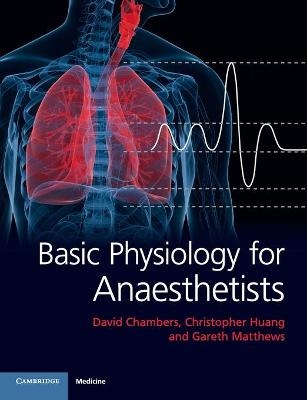
Basic Physiology for Anaesthetists
Cambridge University Press (Verlag)
978-1-107-63782-5 (ISBN)
- Titel erscheint in neuer Auflage
- Artikel merken
Every trainee in anaesthesia requires a thorough understanding of basic physiology and its application to clinical practice. This comprehensively illustrated textbook bridges the gap between medical school and reference scientific texts. It covers the physiology requirements of the Primary FRCA examination syllabus. Chapters are organised by organ system, with particular emphasis given to the respiratory, cardiovascular and nervous systems. The practical question-and-answer format helps the reader prepare for the oral examination, while 'clinical relevance' boxes translate the physiological concepts to clinical practice. The authors include two medical physiologists and a Specialty Registrar in anaesthesia, and thereby bring a unique blend of expertise. This ensures that the book is up-to-date, accessible, and pitched appropriately for the trainee anaesthetist. Packed with easily understood, up-to-date and clinically relevant material, this convenient volume provides an essential 'one-stop' resource in physiology for junior anaesthetists.
David Chambers is a Specialty Registrar in the North West School of Anaesthesia, Manchester, UK. Christopher Huang is Professor of Cell Physiology and Fellow and Director of Medical Studies at Murray Edwards College, University of Cambridge, UK. Gareth Matthews is Translational Medicine and Therapeutics Research Fellow at the School of Clinical Medicine and Physiological Laboratory, University of Cambridge, UK.
Foreword; Preface; Part I. The Basics: 1. General organisation of the body; 2. Cell components and function; 3. Genetics; 4. The cell membrane; 5. Enzymes; Part II. Respiratory Physiology: 6. Lung anatomy and function; 7. Oxygen transport; 8. Carbon dioxide transport; 9. Alveolar diffusion; 10. Ventilation and dead space; 11. Static lung volumes; 12. Spirometry; 13. Hypoxia and shunts; 14. Ventilation-perfusion relationships; 15. West Zones; 16. Oxygen delivery and demand; 17. Alveolar gas equation; 18. Oxygen cascade; 19. Lung compliance; 20. Work of breathing; 21. Control of ventilation; 22. Pulmonary circulation; 23. Oxygen toxicity; 24. Ventilatory failure; 25. Anaesthesia and the lung; Part III. Cardiovascular Physiology: 26. Cardiac anatomy and function; 27. Cardiac cycle; 28. Cardiac output and its measurement; 29. Starling's law and cardiac dysfunction; 30. Pressure-volume loops; 31. Systemic circulation; 32. Arterial system; 33. Arterial pressure waveforms; 34. Capillaries and endothelium; 35. Venous system; 36. Venous pressure waveforms; 37. Lymphatics; 38. Cardiovascular reflexes; 39. Valsalva manoeuvre; 40. Exercise physiology; Part IV. Neurophysiology: 41. Neuronal structure and function; 42. The brain; 43. Cerebrospinous fluid; 44. Blood brain barrier; 45. Cerebral blood flow; 46. Intracranial pressure and head injury; 47. The spinal cord; 48. Resting membrane potential; 49. Nerve action potential and propagation; 50. Synapses and the neuromuscular junction; 51. Skeletal muscle; 52. Muscle spindles and Golgi tendon organs; 53. Smooth muscle; 54. Cardiac muscle; 55. The electrocardiogram; 56. Autonomic nervous system; 57. Pain physiology; Part V. Gastrointestinal Tract: 58. Saliva, oesophagus and swallowing; 59. Stomach and vomiting; 60. Gastrointestinal digestion and absorption; 61. Liver anatomy and blood supply; 62. Liver function; Part VI. Kidney and Body Fluids: 63. Renal function, anatomy and blood flow; 64. Renal filtration and reabsorption; 65. Renal regulation of water and electrolyte balance; 66. Acid-base physiology; Part VII. Blood and Immune System: 67. Haemostasis; 68. Transfusion; 69. Anaemia and polycythaemia; 70. Immune system; 71. Plasma constituents; Part VIII. Energy Balance: 72. Metabolism; 73. Starvation; 74. Stress response; Part IX. Endocrine Physiology: 75. Hypothalamus and pituitary; 76. Thyroid, parathyroid and adrenal; Part X. Developmental Physiology: 77. Maternal physiology during pregnancy; 78. Fetal physiology; 79. Paediatric physiology; 80. Physiology of ageing; Part XI. Environmental Physiology: 81. Altitude; 82. Diving; 83. Temperature regulation; Index.
| Erscheint lt. Verlag | 15.1.2015 |
|---|---|
| Zusatzinfo | 7 Tables, black and white; 161 Line drawings, unspecified |
| Verlagsort | Cambridge |
| Sprache | englisch |
| Maße | 189 x 246 mm |
| Gewicht | 980 g |
| Themenwelt | Medizin / Pharmazie ► Medizinische Fachgebiete ► Anästhesie |
| Studium ► 1. Studienabschnitt (Vorklinik) ► Physiologie | |
| ISBN-10 | 1-107-63782-1 / 1107637821 |
| ISBN-13 | 978-1-107-63782-5 / 9781107637825 |
| Zustand | Neuware |
| Haben Sie eine Frage zum Produkt? |
aus dem Bereich



